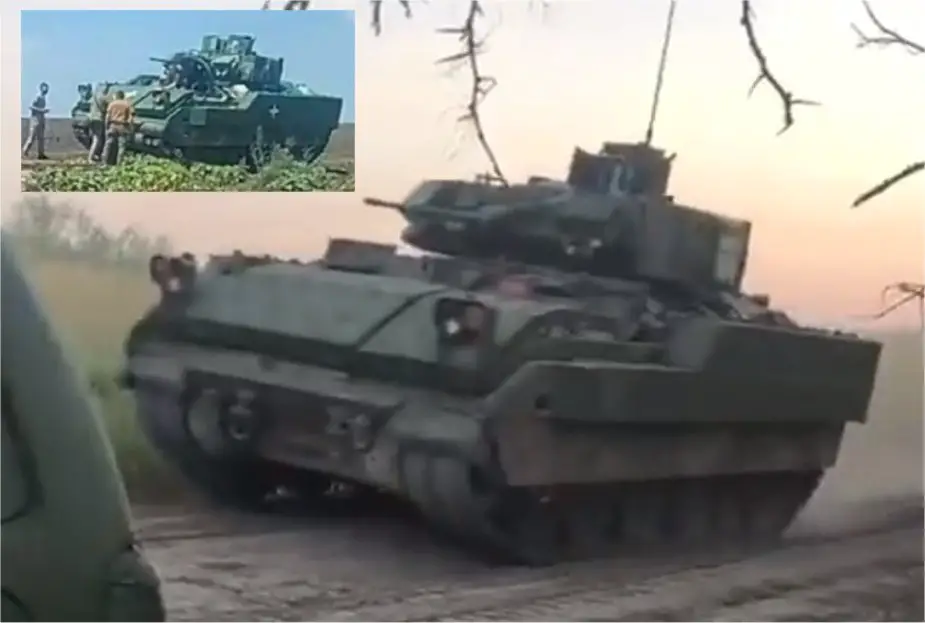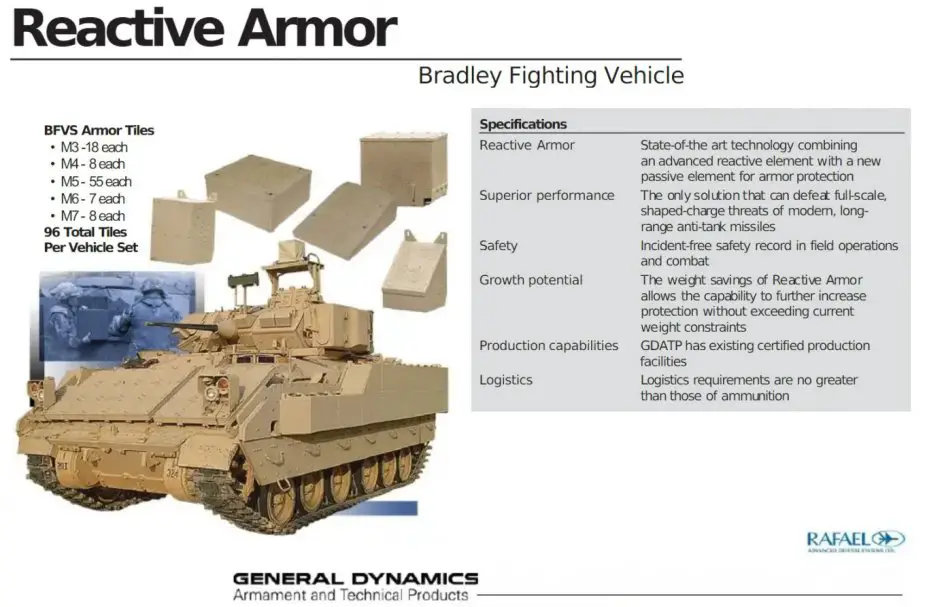Ukrainian Bradley M2A2 upgraded with BRAT reactive armor kit
According to a Telegram post by NMFTE on July 22, 2023, a Ukrainian Bradley M2A2, equipped with the BRAT (Bradley Reactive Armour Tiles) dynamic protection kit, is used in a counteroffensive against Russian positions near the city of Zaporizhzhia, in southeast Ukraine.
Follow Army Recognition on Google News at this link

A Ukrainian Bradley equipped with the BRAT kit, also in clearer view (Picture source NMFTE and Status-6/Twitter)
These Bradley M2A2 tracked armored IFV Infantry Fighting Vehicles are used as a part of a conventional military tactic, along with Leopard 2A6 Main Battle Tanks (MBTs). This tactic involves using different types of forces together to provide mutual support and compensate for each other's vulnerabilities. When we speak of infantry, infantry fighting vehicles (IFVs), and main battle tanks (MBTs), combined arms doctrine is absolutely central, as the Army Recognition editorial team explains in this article.
The mentioned BRAT is actually a common part of standard equipment for this vehicle, it is installed right on the front lines before combat to ensure extra safety for the Bradley.
US deployments in Afghanistan, Iraq, and Syria, apply this protection kit on their Bradley M2A2s. As the name suggests, BRAT was created for this type of vehicle especially.
There are several variants of this armor set, developed jointly by the American company General Dynamics and the Israeli Rafael. The modification used by Ukrainian forces consists of 96 elements (tiles) attached to the front and sides of the hull as well as the turret. The tiles are emplaced on top of a skeleton with fasteners. It can be made even in field conditions.
The exact performance parameters of BRAT elements regarding how well it withstands shaped charge weapons are classified. Although the manufacturers note that the armor set is designed to protect not only against anti-tank rocket-propelled grenades but also against all sorts of modern missiles, including long-range guided missiles.

Composition of the BRAT kit (Picture source General Dynamics and Rafael)
Reactive armor tiles can provide several advantages to the Bradley Infantry Fighting Vehicle (IFV) in terms of increased protection and survivability on the battlefield. These specialized armor tiles are designed to react to the impact of incoming munitions, which can help to reduce their effects. By incorporating reactive armor, the Bradley IFV gains improved survivability, potentially enhancing its ability to withstand various threats in combat situations.
One of the benefits of reactive armor is its potential to protect against shaped charges, which are a significant concern for armored vehicles like the Bradley. When faced with rocket-propelled grenades (RPGs) or other shaped charge weapons, the reactive armor can disrupt the focused blast, potentially reducing the risk of penetration and damage to the vehicle's hull and crew compartment.
Additionally, reactive armor may provide added protection against kinetic energy penetrators, which are solid projectiles designed to pierce armor through velocity and energy. The reactive tiles could help to mitigate the impact of these threats, possibly limiting their penetration capability and providing an additional layer of protection for the Bradley M2A2 IFV and its crew.
Moreover, the use of lightweight materials in modern reactive armor tile design aims to minimize potential mobility and agility drawbacks, allowing the Bradley IFV to maintain its maneuverability during combat.
The modularity of reactive armor tiles is also advantageous, as damaged tiles can be replaced in the field, reducing maintenance downtime and potentially increasing the vehicle's availability for combat missions.
Furthermore, the strategic placement of reactive armor tiles in specific areas where threats are most likely to be encountered could optimize protection and resource utilization.
By potentially reducing the likelihood of penetration and internal damage, reactive armor may contribute to improving crew safety. In case of an attack, the presence of reactive armor might enhance the chances of the Bradley IFV's occupants surviving, which could have positive implications for overall crew safety.
However, it is essential to recognize that reactive armor is not a comprehensive solution and may not protect against all types of threats. As a result, designers of armored vehicles, including the Bradley IFV, often employ a combination of various armor types, such as reactive armor, composite armor, and active protection systems, to offer more comprehensive protection against a wide range of potential threats in modern warfare.























